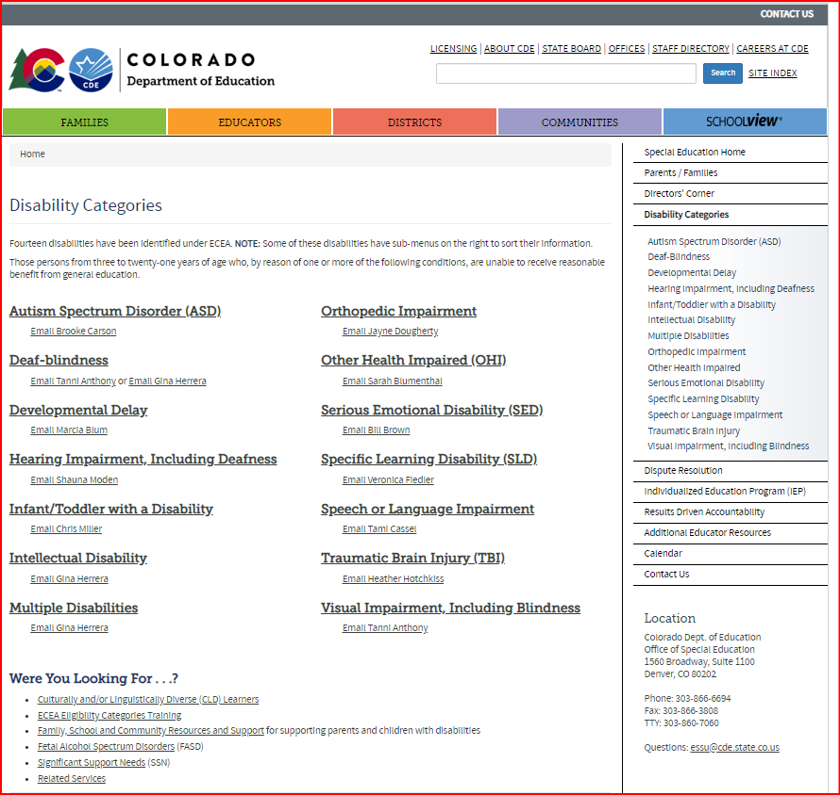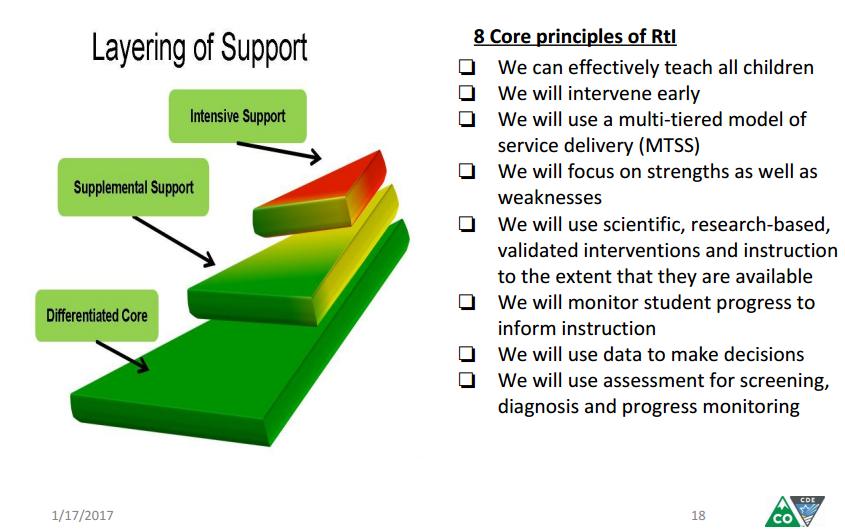Disability Identification Considerations
| Site: | Colorado Education Learning Management System |
| Course: | 2e (Open Access) Supporting Twice Exceptional Learners |
| Book: | Disability Identification Considerations |
| Printed by: | Guest user |
| Date: | Sunday, 14 December 2025, 7:23 PM |
Description
Lesson 2: Identification and Strength-Based Programming
Your District
Take a few moments right now to go to your district's website. What can you find out about Special Education and twice-exceptionality specific to your district?
IDEA and Twice Exceptional
Federal Definition of "Giftedness"
 The US government defines "Gifted & Talented" students as those..."who give evidence of high achievement capability in areas such as intellectual, creative, artistic, or leadership capacity, or in specific academic fields, and who need services or activities not ordinarily provided by the school in order to fully develop those capabilities" (20 U.S.C. Section 7801(22), Wrightslaw: No Child Left Behind, Title IX, Part A, (22), p. 526 and Wrightslaw: Twice Exceptional Children.
The US government defines "Gifted & Talented" students as those..."who give evidence of high achievement capability in areas such as intellectual, creative, artistic, or leadership capacity, or in specific academic fields, and who need services or activities not ordinarily provided by the school in order to fully develop those capabilities" (20 U.S.C. Section 7801(22), Wrightslaw: No Child Left Behind, Title IX, Part A, (22), p. 526 and Wrightslaw: Twice Exceptional Children.
The United States Department of Education states that all schools have an obligation to evaluate all children for special education regardless of cognitive skills (34 CFR §300.304(b)(1) and (2) and 34 CFR §300.8), and while IDEA is silent regarding “twice exceptional” or “gifted” students...it remains the Department’s position that students who have high cognition, have disabilities and require special education and related services are protected under the IDEA and its implementing regulations" (Wrightslaw: Twice Exceptional Children).
In a nutshell:
- IDEA 2004 recognizes twice-exceptional children
- Section 504 and Title II require that qualified students with disabilities be given the same opportunities to compete for and benefit from accelerated programs and classes as are given to students without disabilities
- 2e needs have a priority in U.S. Department of Education grants to guide research, personnel preparation, and technical assistance
Optional reading: A reprint from the 2e Newsletter by Mark Bade outlines how support services can be affected by all three branches of our government — judicial, executive (with its departments), and legislative: Advocating for Twice Exceptional Children.
Determining Disability
In Supporting Twice-Exceptional (2e) Learners Part 2, we go into more depth on different disability categories and how characteristics of these disabilities can manifest in a gifted student, for now, ask yourself, "Where would I start?"
1) Who do you collaborate with; who needs to be at the table to make a special education or 504 Plan determination?
An overview of the disability categories, and much information about them can be found on CDE's Special Education website.

Identifying Colorado Students with Disabilities
Here is a quick-reference guide designed to help educators recognize potential signs of disability in students who are already identified as gifted (credit: Slater, A. E., 2020, Educating Twice-Exceptional Students in Compliance with IDEA and Section 504, LRP publications).
| If a gifted student exhibits the following ... | Monitor the student for additional signs of ... |
|---|---|
| Frequent absences | Anxiety, depression, or other mental health issues |
| Difficulties with attention or focus | ADHD or depression |
| Difficulties with a specific subject or area of curriculum | Specific learning disability |
| Missing or incomplete assignments | ADHD, autism, or emotional disturbance |
| Fidgeting, repetitive movements, or difficulty staying still | ADHD or autism |
| Difficulty with transitions | Autism |
| Difficulties with social interaction | Autism, anxiety, or depression |
| Behavioral outbursts | ADHD or emotional disturbance |
| Frequent disciplinary offenses | ADHD or emotional disturbance |
| Acts of self-harm | Depression or other form of emotional disturbance |
Unlike other gifted students, those who are twice-exceptional find themselves hampered by deficits that interfere with their ability to perform some of the tasks required to learn in the classroom learning. Depending on their disability or disorder, the deficits, often invisible to others, can affect them in various ways, such as:
- Interfere with their ability to make sense of visual or auditory information
- Make it hard to correctly interpret social cues, like facial expressions and tone of voice
- Limit the functioning of short-term memory
- Take the form of language-based disorders that make reading, writing, mathematics, or verbal expression difficult
- Appear as a mood disorder, leaving the child anxious and depressed, or an attention deficit that makes it hard to sit still and focus
- Hamper fine motor skills
- Interfere with the brain's ability to organize and interpret information taken in through the sensory experiences of touch, taste, smell, sight, sound, body placement, and movement (with deficits in the ability to process sensory input, a child reacts to the world quite different from others. Classroom lights, sounds, and smells may seem painfully intense, making concentrating on lessons difficult.)
Remember - 2e children are a diverse group. No one child is likely to display all of these characteristics.
A Peek at Some Numbers
Note: There are no federal laws requiring gifted education services and most states do not collect data on twice-exceptionality; therefore, data on twice-exceptionality is not prevalent.
Data to be considered:
- There are approximately 3.3 million academically gifted children in grades K-12 in the United States, comprising approximately 6% of the total public-school population (2103-2014 NAGC).
- The number of students identified as having a disability in American schools continues to increase; between 2011-2012 and 2017-2018, the population of students who received special education services grew from 6.4 million to 7 million.
- When the data for gifted and special education overlap, we can reasonably estimate that a comparable percentage (approximately 6 percent) of the students served by IDEA must also be academically gifted (Patti Ralabate, The Twice-Exceptional Dilemma, 2006).
Barnard-Brak and colleagues
(2015) estimate that 9.1% of students with identified disabilities may be
academically advanced. Their data below is from
SEELS and represents students in special education who scored >90th
percentile on the WJ-III-R Passage Comprehension, Letter-Word Identification,
Applied Problems or Calculation.
- 9.1% of all children receiving special education services, demonstrate twice-exceptionality with the highest rates for students identified HI, VI, OI, & SLI.
- Only 36 out of these 330 children (11%), who were likely twice-exceptional, reported receiving gifted education.
- The authors note that the parameters of this study likely failed to identify many students with SLD who are also gifted, because they used academic achievement measures, not intelligence measures.
Colorado
In the state of Colorado, in 2018, there were approximately 910,280 pk-12 students. Of the 910,280 identified students, 7.3% were identified as gifted. Of the population identified as gifted, 6.73% were identified as twice-exceptional. 1,518 were gifted with an IEP. 2,913 were gifted with a 504. 61 were gifted with an IEP and a 504.
Current Colorado data is troubling and may reflect the difficulties in identification during the COVID-19 pandemic. In the fall of 2020 There were approximately 883,199 pk-12 students in Colorado (2020-2021). Of the 883,199 students, 7.4% were identified as gifted but only 2.95% of students identified as gifted were also identified as 2e compared to the 6.73% in 2018.
As a result of under-identification we are leaving thousands of students without the support they are due.
IEP versus 504 Plans
Twice-exceptional children are identified as such with either an Individual Educational Plan (IEP) or a 504 in addition to their gifted identification. In the state of Colorado, more students are identified as twice-exceptional with a 504 than with an IEP (almost 2 to 1), so it is important to understand how a 504 can support your gifted students.
Just to clarify for you, Section 504 is part of the Rehabilitation Act of 1973 that guarantees specific rights in federally funded programs and activities to people who qualify as disabled.
Section 504 states:
"No otherwise qualified individual with a disability in the United States...shall, solely by reason of his or her disability, be excluded from the participation in, be denied benefits of, or be subjected to discrimination under any program or activity receiving federal financial assistance...."
Both Individualized Education Programs (IEPs) and 504 plans can offer formal help for K–12 students with learning and attention issues. They’re similar in some ways but quite different in others.
The Understood Team provides a great chart to show the difference between and IEP and a 504. Take a few minutes to review this document.
Many twice-exceptional students are identified as gifted with a learning disability but are receiving accommodations through a 504 plan. Why? Later we will take a look at the three conceptual groupings of twice-exceptional students that help you understand why 504 plans are more common than IEPs for 2e students. For now, here are some potential signs that a gifted student may need a 504 plan (credit Slater, A., 2020. Educating Twice-Exceptional Students in Compliance with IDEA and Section 504) :
- Poor organizational skills
- Trouble completing assignments
- Time-management problems
- Difficulty understanding or following directions
- Distractibility or difficulties with focus
- Frequent medical-related absences
Note:
For more information about 504 plans please visit the US Dept. of Education - resources on Section 504 of the Americans with Disabilities Act [ADA])
Accommodations, Interventions, Modifications, Oh My!
When you hear those three words "accommodations, interventions, modifications" what comes to mind?

Somehow those three words have attached themselves to negative connotations. We think something is wrong, and we need to accommodate, intervene, modify, but what if something is right, and we still need to accommodate, intervene, and modify? Such as the student who has accomplished all grade level expectations in their math lesson this week, or they have exceeded your expectations in your reading lesson. What do you do then? You have to make a program change to meet their needs - just like the child who might need the remediation.
Consider this:

If you look at the image on the left side of the screen, that is the RtI triangle lying flat on its back. If it was standing up you would see the distinct layers of tiered instruction: green (tier one - universal), yellow (tier two - supplemental), and red (tier three - intensive). When they are lying on their back you can see how the layers of instruction blend together and might be flexible for students. For instance, every child, every day should be receiving universal instruction (tier one) - this is grade level expectations that every child needs to master. If the child has mastered the universal instruction, OR if they need some extra time to master the universal instruction, you will move the child into a tier two frame. What this means is an adjustment will happen for this child that is more targeted instruction for their personalized needs--this could be seen as an accommodation, intervention, or modification. While they are receiving THEIR targeted instruction, they will also be receiving some universal instruction along the way so that they don't loose touch with what is happening in class. If they master their tier 2 instruction, OR need even more time with the skills, then the child moves to tier three support but notice how there is still green (universal) and yellow (supplemental) mixed in with the red (intensive.) This needs to be a fluid process for students and teachers because from day to day, hour to hour, minute to minute, you might have to adjust the student's level and intensity of instruction.
So, what does the student need?
Accommodations:
Interventions:
Modifications:
Modifications are generally made for students with significant cognitive or physical disabilities. Allowing a study to do fewer problems on a test would be a modification. A modification is a change in the course of study, standards, test preparation, location, timing, scheduling, expectations, student response and/or other attributes which provide access for a student with a disability to participate in a course, standard or test. It does fundamentally alter or lower the standard or expectation of the course, standard or test.
For more examples see HERE (optional).